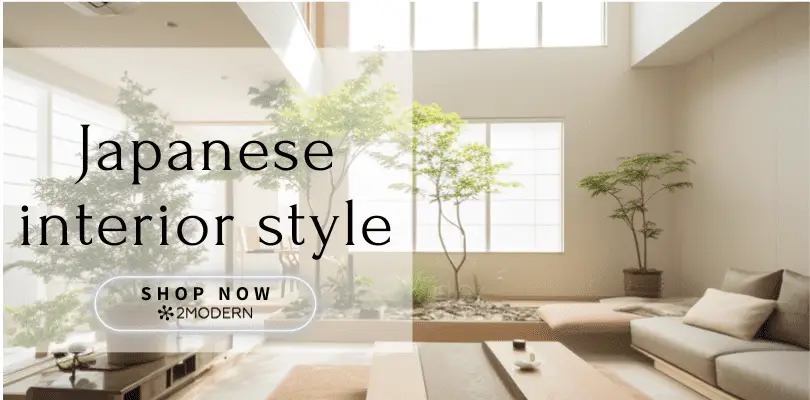
Japanese interior design has gained worldwide popularity due to its simplistic beauty and calming aesthetic. Rooted in ancient traditions and philosophies, it offers a harmonious living space that promotes mindfulness, relaxation, and a deep connection with nature. In this article, we’ll explore the philosophy behind Japanese interior design, its key elements, and how you can integrate it into your own home.
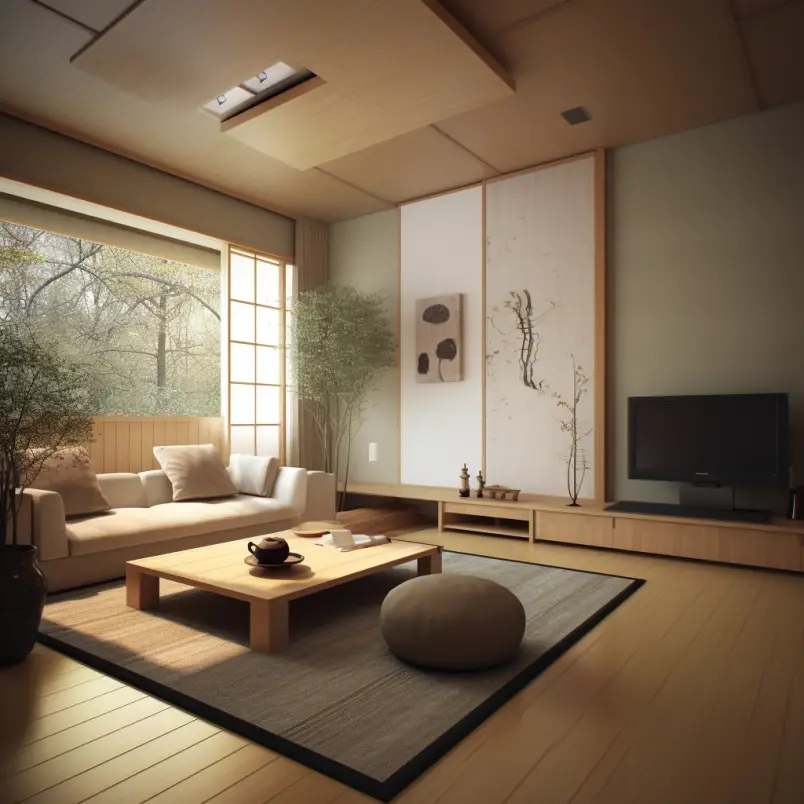
Table of Contents
The Philosophy Behind Japanese Interior Design
Wabi-Sabi
Wabi-sabi is a Japanese concept that embraces the beauty of imperfection and impermanence. In interior design, wabi-sabi means appreciating the natural imperfections of materials, like wood grain, and celebrating the character that comes with age and wear. This philosophy encourages us to find joy in the humble and imperfect aspects of life, ultimately fostering a sense of contentment and gratitude.
Zen Buddhism
Zen Buddhism is another core influence in Japanese interior design, emphasizing the importance of harmony, balance, and simplicity. It encourages the creation of tranquil spaces that help foster mindfulness and inner peace. Zen-inspired interiors often feature minimal clutter and carefully chosen elements that reflect a deep respect for the natural world.
Minimalism
Minimalism plays a significant role in Japanese interior design, promoting the idea that less is more. By reducing clutter and unnecessary items, Japanese interiors create a sense of serenity and calm, allowing the space to breathe and the occupants to focus on what truly matters.
Key Elements of Japanese Interior Design
Natural Materials
Japanese design embraces nature, using natural materials like wood, bamboo, paper, and stone to create a warm and inviting atmosphere. These materials not only provide a strong connection to the earth, but also evoke a sense of timelessness and authenticity.
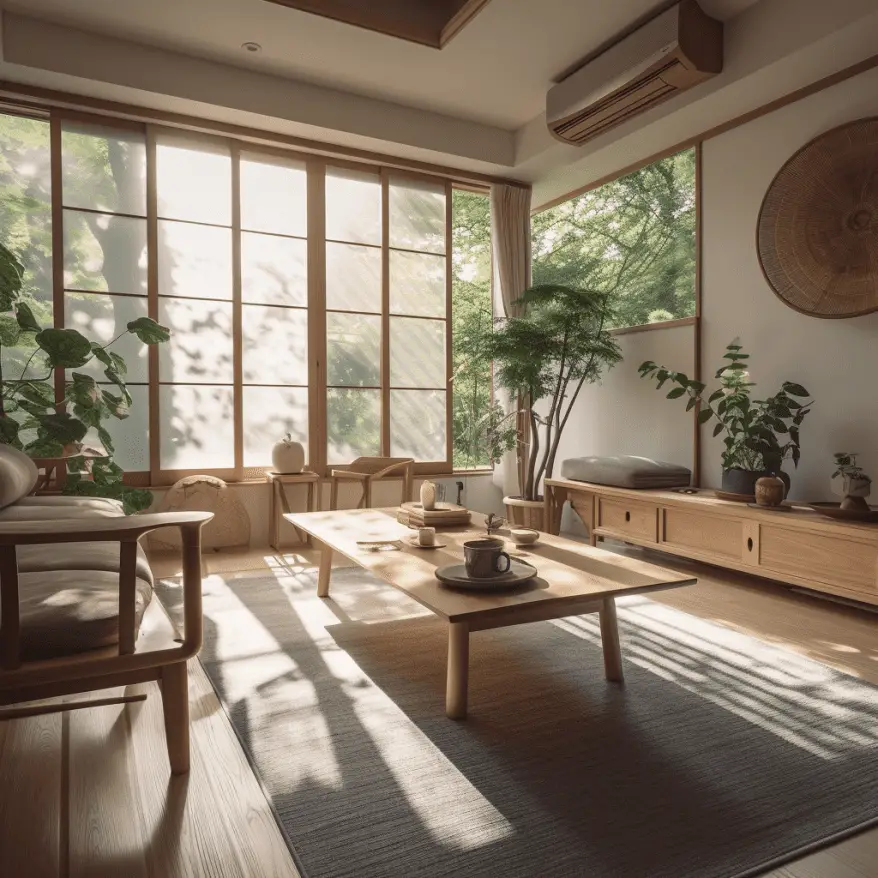
Space and Simplicity
Open and uncluttered spaces are a hallmark of Japanese interiors. By maintaining simplicity in both design and decor, these spaces promote tranquility and foster a deep sense of relaxation. Storage solutions are often hidden or incorporated into the architecture, ensuring a clean and minimalist appearance.

Sliding Doors and Screens
Sliding doors, or shoji, and folding screens, or byobu, are essential components of Japanese interior design. Made from wood and translucent paper, shoji doors allow natural light to filter through, creating a soft and diffuse glow. Byobu screens are used to divide spaces or hide clutter, providing flexibility and privacy without sacrificing the openness of the room.
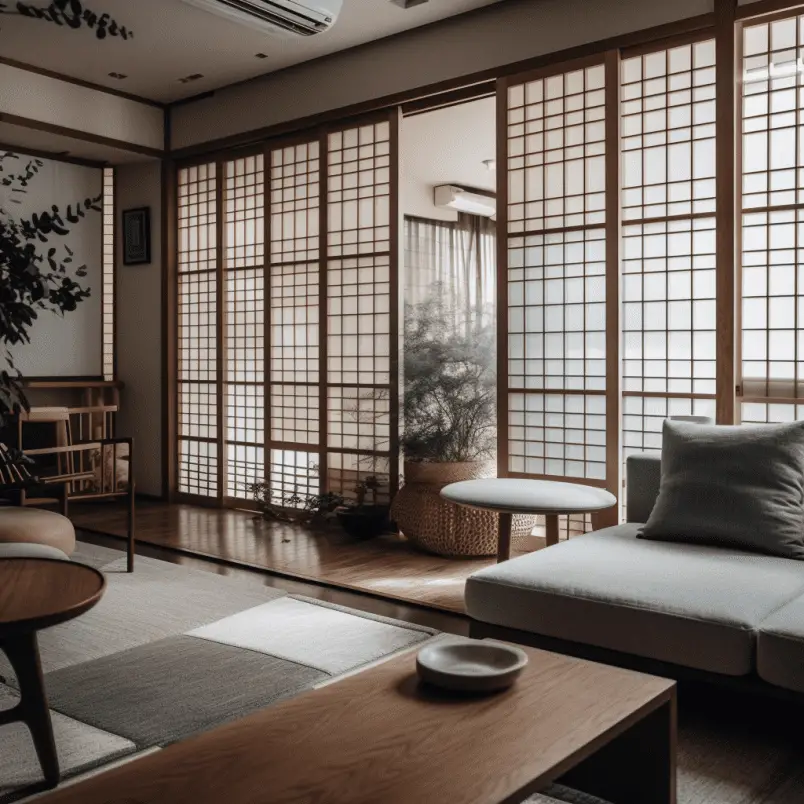
Low Furniture
Traditional Japanese homes feature low furniture, like tatami mats, floor cushions, and low tables. This design element encourages a more grounded and connected lifestyle, while also creating an illusion of spaciousness. Low furniture also adds to the room’s overall sense of tranquility and comfort.

Neutral Color Palette
Japanese interiors typically use a neutral color palette, featuring shades of white, beige, and gray, with subtle pops of color from natural elements like plants or artwork. This understated color scheme allows the space to feel calm and uncluttered, promoting a sense of serenity and balance.
Integrating Japanese Interior Design into Your Home
Incorporating Tatami Mats
Tatami mats are a versatile and traditional way to bring Japanese design into your home. Made from woven straw, these mats can be used as flooring or placed beneath low furniture for added comfort. Their natural texture and color also contribute to the overall aesthetic of the space.
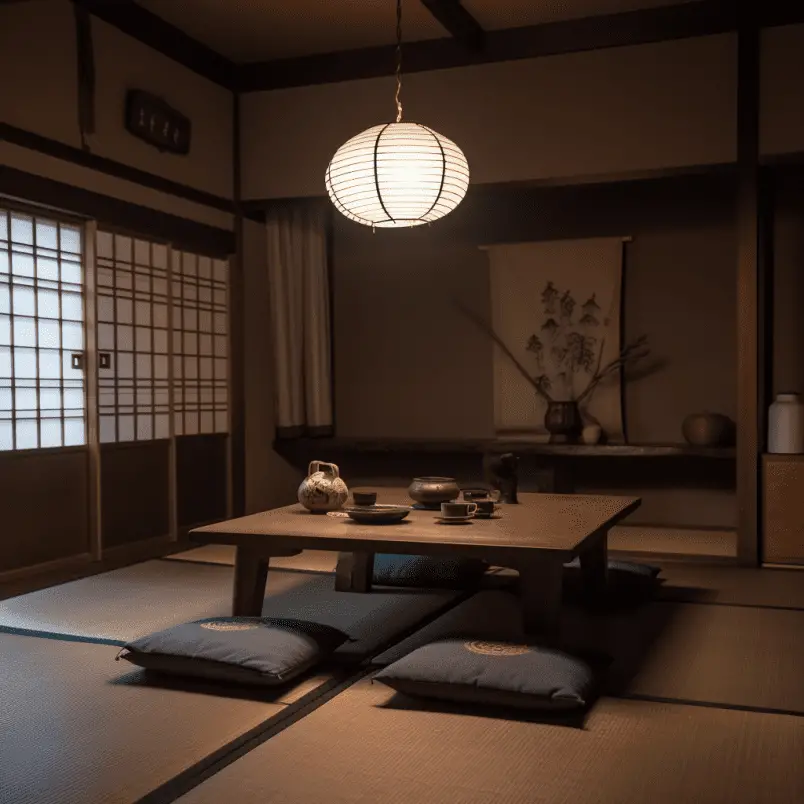
Bringing Nature Indoors
Incorporating elements of nature into your home can help you achieve a Japanese-inspired design. Consider adding houseplants, a small water feature, or a rock garden to bring the outdoors in. Even simple touches like a vase of flowers or a bowl of stones can have a significant impact.
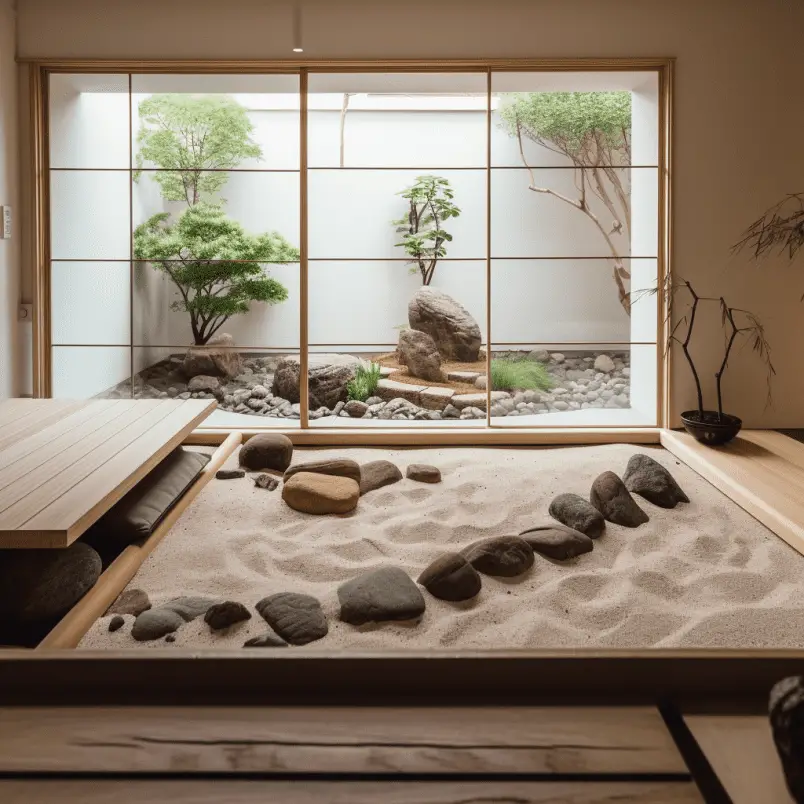
Creating a Zen Corner
Designate a quiet space in your home as a Zen corner, where you can relax, meditate, or practice mindfulness. This space should be clutter-free and include elements like a comfortable cushion or chair, a small table, and perhaps a soothing piece of art or calming candles.
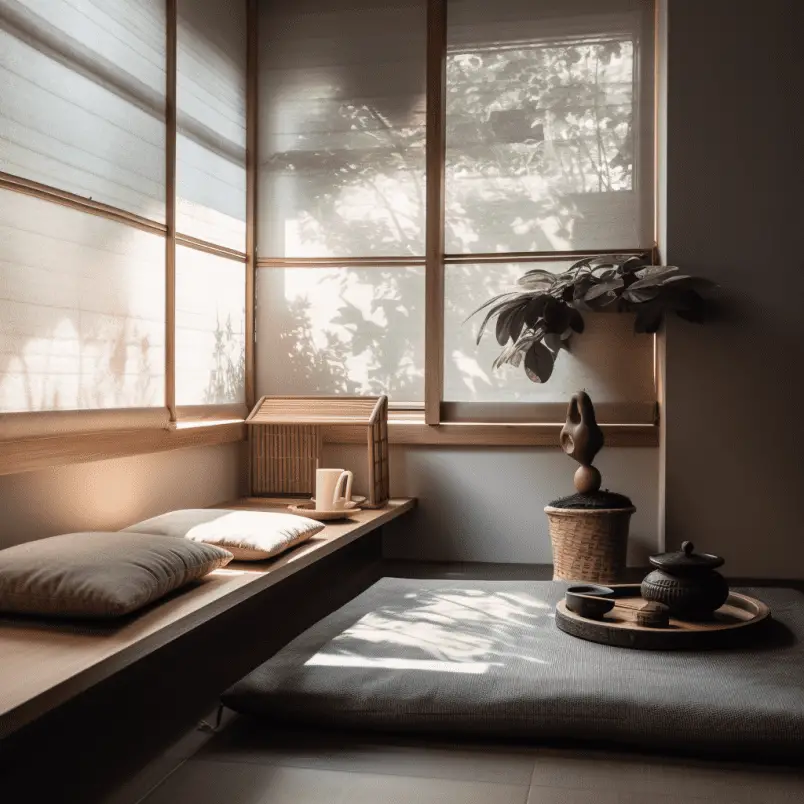
Focusing on Lighting
Lighting plays a crucial role in creating a peaceful Japanese interior. Opt for soft, ambient lighting using lamps, lanterns, or candles to create a warm and inviting atmosphere. Diffuse natural light with shoji screens or sheer curtains to maintain a sense of calm and tranquility throughout the day.

Pros and Cons of Japanese interior design
Japanese interior design has gained popularity worldwide due to its minimalist and calming aesthetic. However, it is not without its drawbacks. Here are some pros and cons of Japanese interior design:
Pros:
- Minimalism: Japanese interior design is known for its minimalist approach, which often results in clutter-free, organized spaces. This can promote a sense of tranquility and focus.
- Natural materials: Traditional Japanese design incorporates natural materials like wood, bamboo, and paper. These materials lend a warm, organic feel to the space and have a lower environmental impact compared to synthetic materials.
- Space efficiency: Japanese interiors are often designed to make the most of limited space, incorporating multi-functional furniture and storage solutions. This can lead to well-organized and practical living spaces.
- Connection to nature: Japanese design emphasizes the importance of nature, often integrating indoor and outdoor spaces through features like sliding doors and large windows. This can create a harmonious atmosphere and promote well-being.
- Zen ambiance: Japanese interiors often have a calming, Zen-like quality, thanks to their use of soothing colors, soft lighting, and natural elements. This can create a peaceful environment, conducive to relaxation and stress relief.
- Timeless appeal: The principles of Japanese design have endured for centuries and can be applied to modern spaces, making it a timeless and versatile style.
Cons:
- Lack of privacy: Traditional Japanese homes often have open layouts and sliding doors made of paper or other translucent materials. This can lead to a lack of privacy, particularly in smaller living spaces.
- Cost: The use of natural materials and specialized craftsmanship in Japanese design can be expensive, particularly when sourcing authentic or high-quality materials.
- Limited color palette: Japanese interior design usually relies on a restrained color palette, which may not appeal to those who prefer bold or vibrant colors.
- Minimalism not for everyone: The minimalist approach of Japanese design may feel too sparse or uninviting for some people, who may prefer a more eclectic or cozy style.
- Cultural appropriation concerns: Non-Japanese designers and homeowners should be sensitive to the risk of cultural appropriation when incorporating elements of Japanese design. It is important to research and respect the cultural significance of specific design elements.
- Climate considerations: Some elements of Japanese design, such as open layouts and the use of natural materials, may not be suitable for all climates, particularly those with extreme temperatures or humidity.
Conclusion
Japanese interior design offers a timeless and elegant approach to creating spaces that promote harmony, balance, and well-being. By incorporating elements like natural materials, minimalism, and a strong connection to nature, you can transform your home into a tranquil haven that fosters mindfulness and relaxation. Whether you choose to incorporate just a few Japanese-inspired touches or fully embrace the design style, you’ll be sure to create a space that feels serene and inviting.
FAQ
What are the main principles of Japanese interior design?
The main principles of Japanese interior design include wabi-sabi (embracing imperfection), Zen Buddhism (creating harmony and balance), and minimalism (reducing clutter and focusing on simplicity).
How can I incorporate Japanese design elements into my home?
You can incorporate Japanese design elements by using natural materials, creating open and uncluttered spaces, adding low furniture, dividing rooms with sliding doors or screens, and incorporating neutral colors with pops of nature.
What is the purpose of a Zen corner?
A Zen corner is a designated space in your home that promotes relaxation, meditation, and mindfulness. It should be clutter-free and include calming elements to help create a peaceful atmosphere.
How can I achieve a Japanese-inspired lighting scheme in my home?
To achieve a Japanese-inspired lighting scheme, focus on soft, ambient lighting using lamps, lanterns, or candles. Diffuse natural light with shoji screens or sheer curtains to create a calming atmosphere throughout the day.
Can I incorporate Japanese interior design elements into a small space?
Yes, Japanese interior design is well-suited for small spaces due to its emphasis on simplicity, minimalism, and open layouts. By using low furniture, decluttering, and incorporating flexible room dividers like shoji screens, you can create a sense of spaciousness and tranquility even in smaller living areas.
